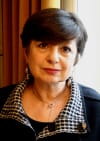
Intersecting paths across mathematics, biology, and epistemology: A colloquium in honor of giuseppe longo and ana soto
In this colloquium, we celebrate the 75th birthdays of Giuseppe Longo and Ana Soto. We have chosen to show their distinct trajectories and then how they intersect while working on the foundations of theoretical knowledge with a biology focus. In this respect, both Giuseppe Longo and Ana Soto maintain a close relationship with philosophy and philosophers. At the same time, both are also involved in “the life of the polis”, this is, addressing the repercussions of science in society and the environment, both as scientists and intellectuals.



